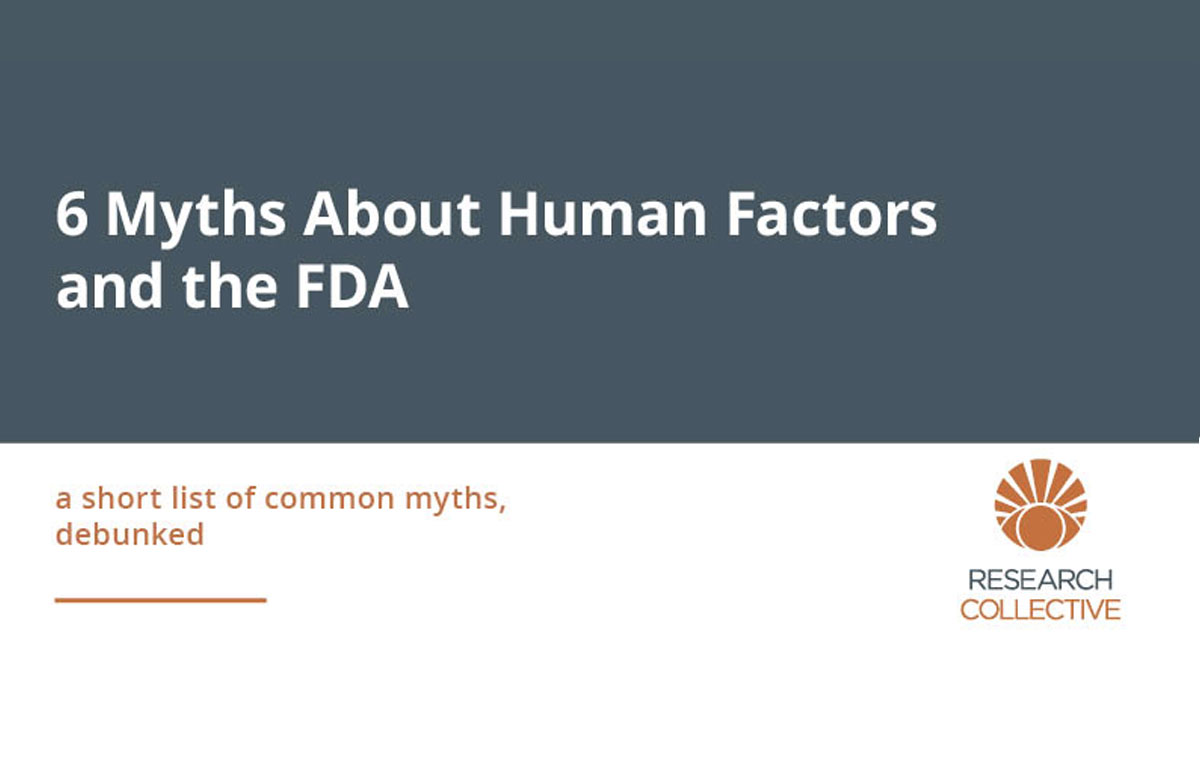Human Factors Engineering and FDA Clearance
Human factors validation testing and obtaining FDA clearance can be challenging. Even folks who fully understand these processes can struggle to execute efficiently. Where do these challenges come from?
Research Collective has worked with dozens of medical device manufacturers over the years. During this time, we have seen a host of problems arise, some large and some small. Of course, each problem is unique, but one consistency seems to shine through regardless of the project: There are numerous misconceptions about human factors and about the FDA amongst medical device manufacturers. Many issues come from preconceived notions that aren’t true and something arduous becomes even more challenging than it already is.

We have accumulated a short list of common myths about human factors and the FDA submission process for medical devices. Our goal is to help prevent unnecessary confusion in a process that isn’t always intuitive for the people navigating these regulatory pathways. Let the debunking begin!
Myth 1. The FDA Guidance is a comprehensive representation of human factors.
Medical device manufacturers often consult the FDA Guidance on human factors for advice on successfully navigating a 510(k) submission. Unfortunately, the language in the Guidance has led people to believe that the methods/strategies represented are all that human factors has to offer. This stems from the fact FDA’s view of human factors is primarily comprised of ensuring medical devices are safe to be used by their intended users.
Of course, human factors is much more than a single document that helps you get FDA clearance or approval. It is an incredibly broad and complicated discipline comprised of medicine, psychology, sociology, anthropology, design, and engineering, among others. The goal of human factors, in addition to creating safe products, is to develop user-friendly, comfortable, and satisfactory solutions as well. The work that goes into achieving these goals is much more than that of reducing the risk of critical use errors. The FDA Guidance simply applies human factors principles to a specific medical context.
Myth 2. All medical devices are required to go through human factors validation testing.
Unless specific regulatory or statutory requirements are applicable to your medical device, human factors testing is not required for most submissions. It’s true; more than likely, your medical device is not required to do any human factors anything.
We find that it’s important to note, however, that the FDA does explicitly suggest that manufacturers implement human factors engineering. The FDA guidance document Applying Human Factors and Usability Engineering to Medical Devices itself reads:
FDA’s guidance documents, including this one, do not establish legally enforceable responsibilities. Instead, guidance documents describe the Agency’s current thinking on a topic and should be viewed only as recommendations unless specific regulatory or statutory requirements are cited. The use of the word should in Agency guidance documents means that something is suggested or recommended, but not required.”
Myth 3. FDA doesn’t require human factors testing for my device, so I shouldn’t care about it.
“I’m not required to perform human factors testing? Sweet! Budget saver!”
Not so fast. First of all, remember what the guidance said: human factors engineering is suggested and recommended. FDA likes to see it in the submissions they review.
Second, just because human factors testing is not explicitly required does not completely exempt manufacturers from doing so for internal documentation purposes. For example, manufacturers would be wise to document human factors validation testing in their design history file. Human factors research strengthens your submission. Especially if your medical device can lead to harm, reviewers will want to see human factors documentation. Those same reviewers can request that your organization perform human factors testing.
Third, checking off a “human factors” box should never be the sole reason for employing human factors methods. Usability testing can identify safety issues and can help inform a better product that users will want to buy. How can you argue against a better product? Not only that, human factors and usability engineering is an investment that can protect your company against harmful litigation; if you can show the court that you conducted HFE/UE testing, they will be much more keen to judge in your favor.
Myth 4. The FDA is inaccessible.
There is often a perception that the FDA is inaccessible for questions or feedback outside of the submission itself. Fortunately, this is not true.
In fact, the FDA encourages medical device manufacturers to establish lines of communication before the submission date. Representatives from the FDA can be available for things like informational meetings, reviewing human factors study plans, or simply making the review team aware of specific details about the device. If you are unsure of the steps your development team are about to take, it may be smart to ask the FDA for feedback in advance. Information about pre-submissions (also known as Q-Submissions) can be found here.
For the record, we strongly recommend taking advantage of Q-Subs!
Myth 5. You can’t have any use errors during validation testing.
The ideal human factors validation report does not note any use errors on critical tasks. In the best case scenario, each user should be able to complete critical tasks without difficulty. This is ideal, but not realistic.
The FDA does not expect every critical task to be free of use errors. Remember that the FDA is looking for signs that people might get hurt if the device goes to market; they are trying to maximize safety. One or two use errors for a critical task are not likely to be a big deal unless it is clear the manufacturer can do something to mitigate the risk.
Additionally, keep in mind that the FDA is looking for patterns of the same use errors occurring over time. They will be much more likely to question a single critical task with five use errors than they will be multiple use errors spread across several critical tasks. Five critical tasks with one use error apiece equal the same number of use errors, but that is not necessarily evidence that a specific use error will occur repeatedly in the future.
Myth 6. The FDA are the bad guys.
Like any regulatory body, the FDA has to enforce standards that can be difficult to comply with. It’s easy for medical device manufacturers to feel like the FDA is out to get them.
Of course, this couldn’t be further from the truth. It is important to remember FDA’s role in reviewing human factors documentation: “to maximize the likelihood that new medical devices will be safe and effective for the intended users, uses, and use environments”. It all comes down to safety. If your reviewer has an issue with something, it is an honest and sincere concern related to human factors.
Believe it or not, FDA wants new and innovative medical devices to be cleared. Technological advances are a good thing! But devices that are new are (naturally) untested. The latest isn’t so great if people get hurt.
So, give the FDA some slack. Everyone has a job to do, and they are absolutely willing to help if you follow the appropriate channels.
Conclusion
Human factors validation testing and the FDA Guidance on human factors can be difficult to navigate, but they don’t have to be. Don’t let silly misconceptions make something challenging even more trouble than it already is. It all starts with knowing the basics and knowing them early. If something isn’t clear, do not be afraid to ask. Maybe it’s a consultant or maybe it’s the FDA themselves.
Which myths have we missed? Is there anything that you believed about the FDA, but now know better? We’d love to hear about your stories!




